The Utopia, armarium codicum bibliophilorum collection (roughly translates to bookshelf of book-lovers) hosted at e-Codices is the location for privately-held manuscripts who’s owners allowed them to be digitized, but do not wish to be known. From that two books have been recently added, cod.109 and cod.111. Both of these are mid-15th century manuscripts from France, but after that they are distinctly different.
Cod.109 is from Angers, once the capitol of Anjou and about 300km from Paris, and dates from about 1430. It isn’t an unusually beautiful hours, but nicely executed with bright colors and wide borders filled with tiny leaves. The calendar is mostly full, with about 50 empty dates, though there is not a single feast with 2 different saints, not even the common pairing of St. James 1761 and St. Christopher 1757 on July, 25. The error rate is pretty low, only 18, but they seem to come in groups. Some unusual saints seem to reflect the uncommon use, such as St Gratian 3418 (in red) on October 23.
(Db ID: 260)
Another early manuscript from the Walters Art Museum, W.37 is a early 14th C (1300-1310ish) Book made for the Use of Liege, probably for a Beguine living in Huy (Belgium, south-west of Liege). The manuscript has a series of full-page miniatures between the calendar and the Hours of the Nativity of the Virgin, and does not contain the standard Hours of the BVM.
The Calendar is rather bare, with only 160 entries in total. The entries are very accurate in content, none were unidentified and only 2 were on the wrong date, both by a single day. There are several unusual saints, mostly localized to Liege, including Count Mengold on February 8 (4244).
That is not to say that the calendar is without error, however, as there are two sorts of error present. The black entries were penned before the miniatures, and in multiple cases the miniature has over-painted the text. This is most obvious in the later months, in December(see f.8v below) the Nativity of the Virgin is missing the entire last word, due to the Labor of the Month. Additionally the red entries were done by a poor scribe, the hand is extremely shakey and inconsistant. This red-ink scribe neglected to include at least one feast, there is a Vigil for St. Laurence on August 9 (651) but no entry for the feast on the 10th.
(DB Id: 93)
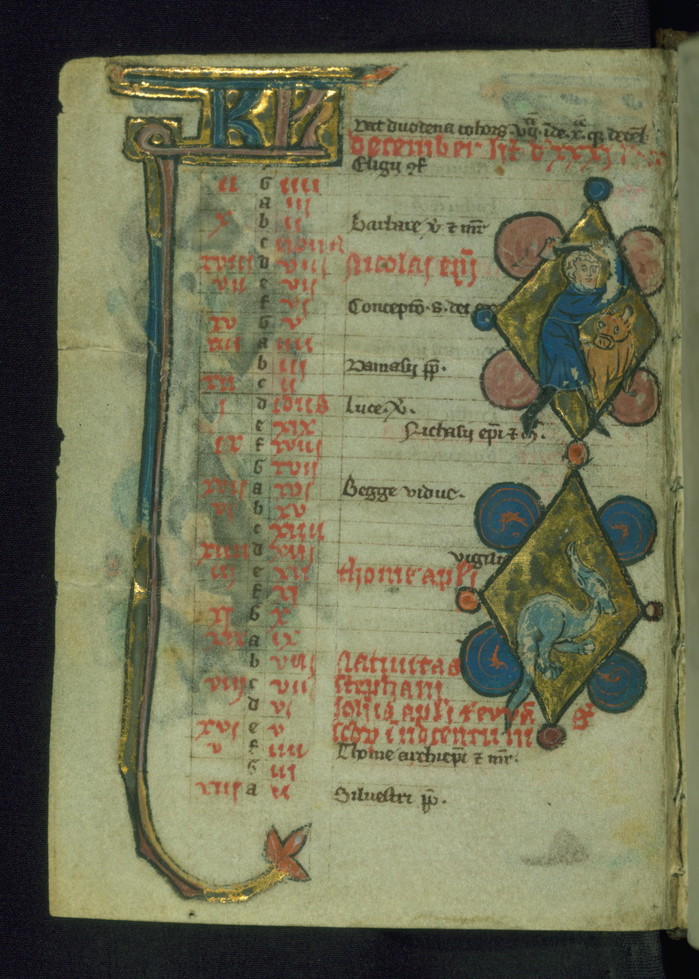
W.86 from the Walters Art Museum is an early manuscript from Arras, near Calais. It dates to the late 13th century, making it an early example. Like many 13th C Hours, it has some unusual contents, in this case a series of six miniatures depicting the Passion between the Calendar (1r-12v) and the Hours of the of the Virgin, which start with a striking full-page historiated initial on f.19r. The Calendar is also interesting both due to it being in Old French and due to the large number of errors and unidentified saints. There are 17 errors and 47 unidentified entries, or roughtly 30% of the 198 total. Some of the unidentified saints have clear readings, but have no matching known feast. Others, such as Waubort on November 15(see f.11r below), are French translations of known saints, in this case St Walburga, but still are unmatched for the date.
(DB Id: 256)
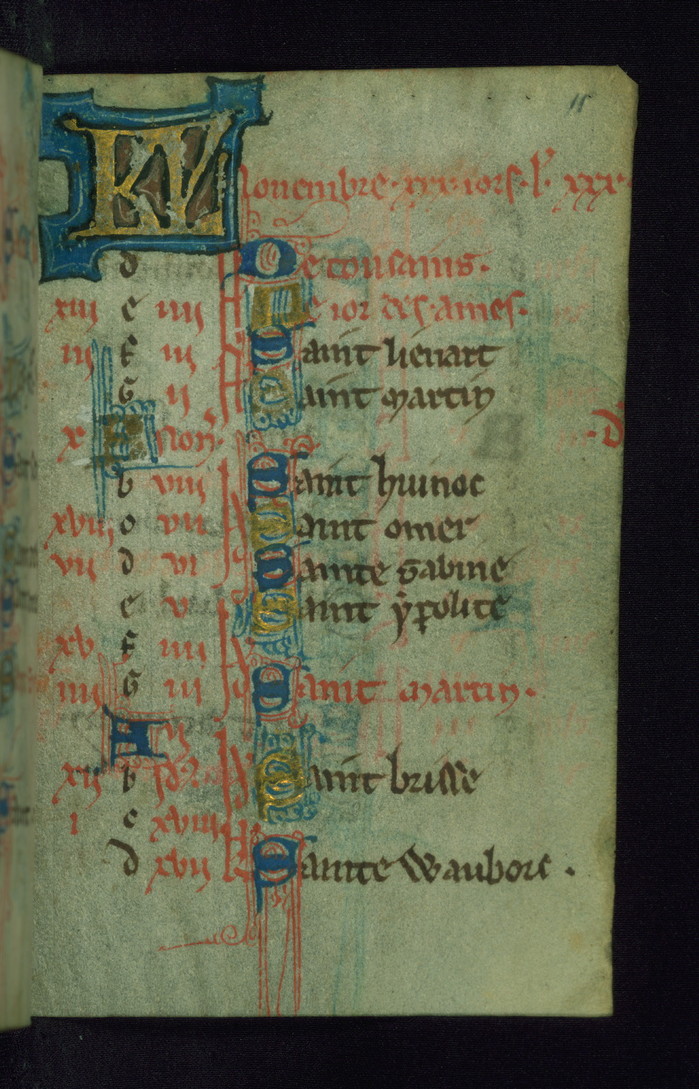
It’s not linked into all the proper places, but the initial “date detail” function is finally implemented. In the same basic mode of operation as “saint detail”, this returns a page with all the entries known for a particular date, as well as information about that date (currently Dominical Letter, Golden Number, and Roman Date). Future work will include some distribution graphs and a “Notes” field for the date, but at least there is a minimal function out there. Currently it is only linked from the date number in the “Saints by date” page, but that may increase.
There are a pair of permanent links, one as date id: http://cokl.wiglaf.org/p/v100/dateid/210
and another as the month/day: http://cokl.wiglaf.org/p/v100/date/7/29
Back to Bibliothèque de Genève manuscripts, hosted by the excellent e-Codices. MS Lat 367 is a book made in Lyon for the Use of Geneva, which is an uncommon liturgical localization. It dates to the early 16th century, but post 1511 as some of the illustrations by the Maître de l’Entrée de François I are based on images in Durer’s 1511 Petite Passion.
The calendar is not complete, but nearly so with 359 entries and a few non-feasts indicated, such as “Dies Egyptia” on March 28. The entries have some accuracy issues, with at least 12 on the wrong date. There’s also an interesting scribal error in September (see f.10r below), where Cornelius and Cyprianus (3696) are listed on both the 14th, the correct date, and on the 13th as well. Many of the identified saints are unique or rarely seen in other calendars.
(DB Id: 249)
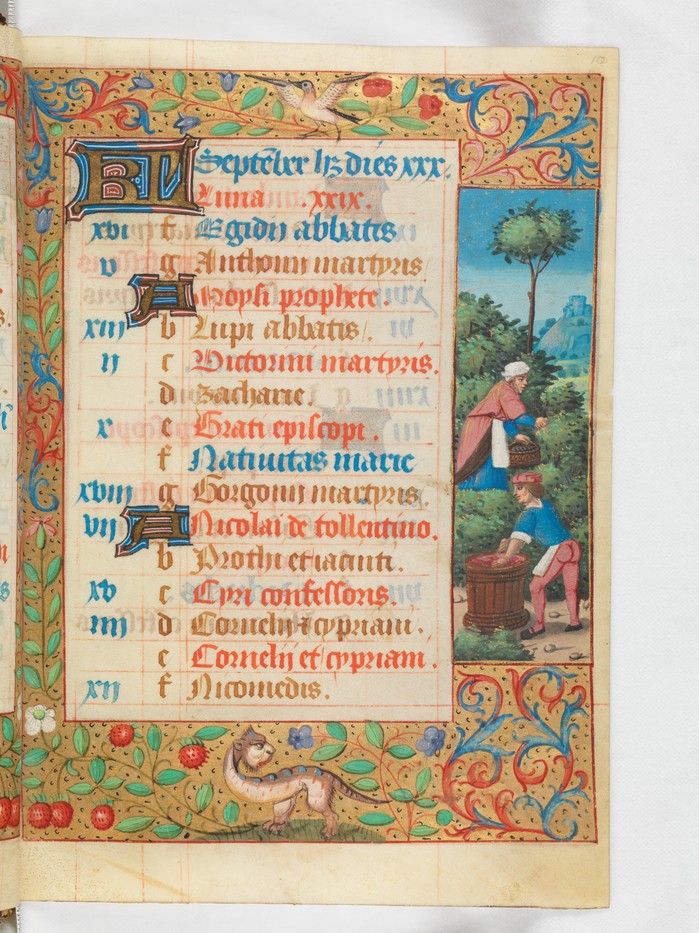
Taking a break from the e-codices stuff, the Vatican uploaded one of their Sanvito Books, Vat.lat.9490. This one is both Use of Rome and made in Rome, and entirely on purple vellum. The calendar is written in gold and silver, with silver for the high-importance feasts and gold for the regular. The calendar is exceptionally accurate, 2 saints are offset a single day and not a single one is unidentifiable, out of 205 entries. There is a decidedly Fransiscan slant to the saints, with the feast of his Stigmatization(3722) and the Translation of St. Clare(3359), both in silver, and the Octave of his Feast(3992) and the feast of Peter Martyr(273), both in gold. In an unusual bit of scribal whim, some few saints are written as "Saint Martyr Name", versus the more common "Saint Name Martyr", for example see Trifonis & Respici on November 10, below f.13r
(DB Id: 251)
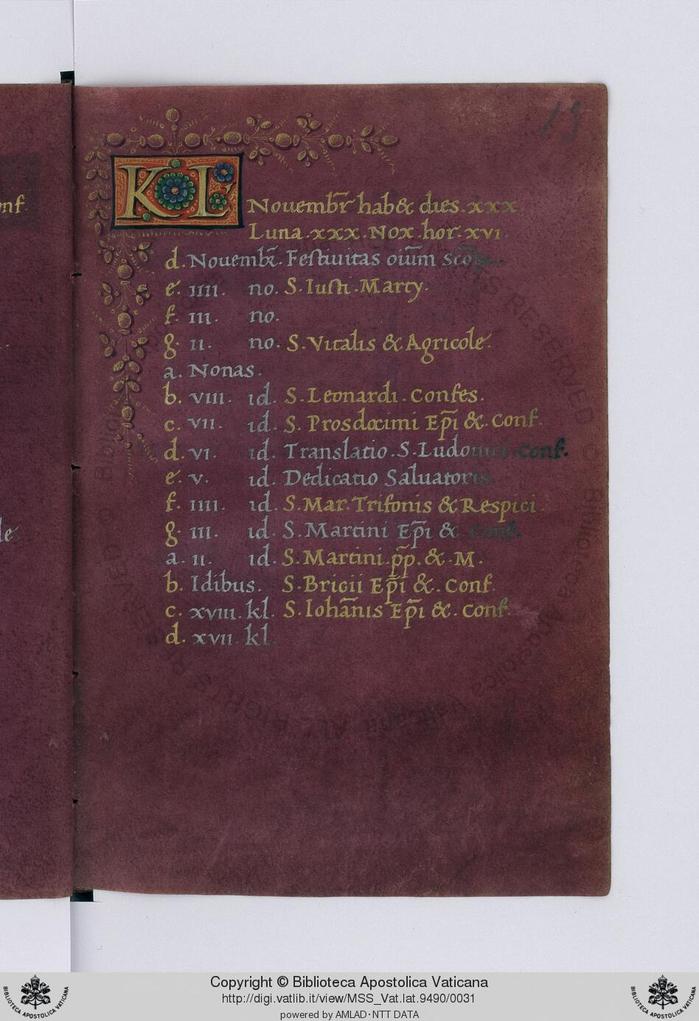
We know more about the location of manuscript MS Lat 34 from the Bibliothèque de Genève, hosted by the excellent e-Codices, than we usually do. This was made for use in the Abbey of St. Martin, in Tours, France. Sadly the monastery was destroyed during the revolution due to St. Martin’s connection to the royal family, dating back to Clovis. The modern Basilica of St. Martin was built on the same site in the late 19th century.
The calendar is unusual in containing a large amount of non-festal dating. All of the Egyptian days are marked in full and there are the “keys” to both Rogation and Pentecost, though not for Easter, which is the most common. For Easter, there is a little poem on the outer margin of the first part of January (see f.3r below) that gives a simplified way of predicting the date. There’s also an entry for the day of Creation, according to Bede and the yet-unexplained “Septim[us] embolism[us]”. The saints are as expected. There are several feasts for St Martin, including the common, Translation on July 4 1854, and the uncommon, Subvention on May 12 2543, Octave of Translation on July 11 4220
(DB Id: 246
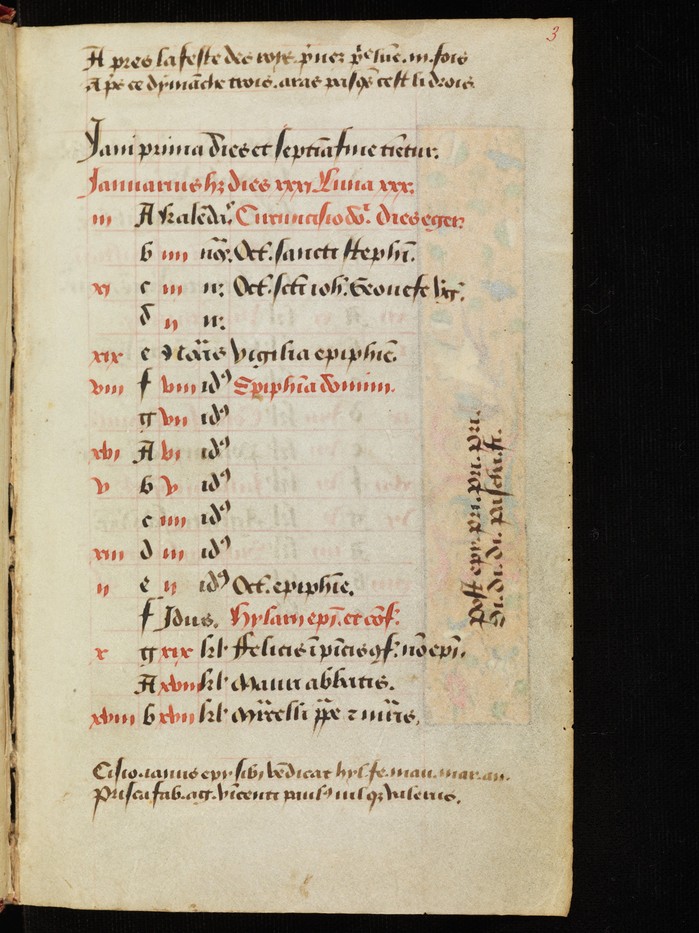
The another manuscript from the Bibliothèque de Genève, hosted by the excellent e-Codices site, was made for use in Nantes, MS Lat 33. It is lavishly decorated throughout, with block-borders on almost every text page and filled pages to start the hours and each month in the calendar.
The calendar is unusual in that it is unranked. There is a strick alternation of blue/gold for the entries, with no distinction for high-importance feasts. Also somewhat unusual is the line-fillers for every day. The saints are rather error-prone, with at least 43 noted on the wrong date. Several more names have become quite corrupt, for example St. Ballece, December 3 (see f.12r below), is most likely meant to be St. Barbara, December 4 853
(DB Id: 241)
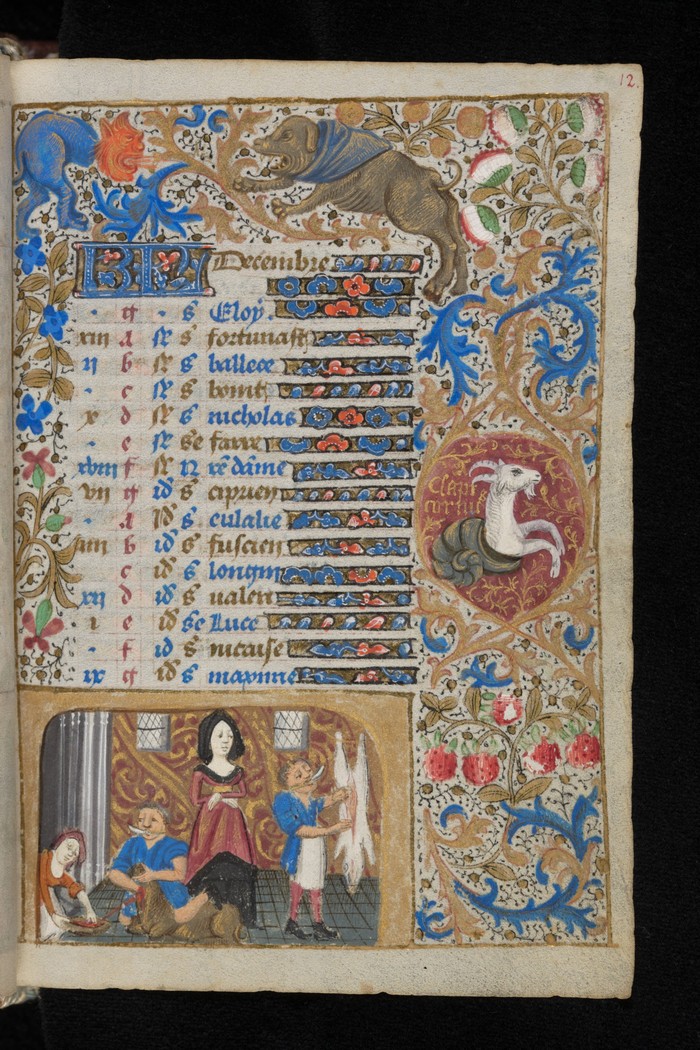
A code update was pushed along with the addition of this MS to properly store manuscripts with unranked saints. This is unusual, so far there are only 3 manuscripts in which the color change does not seem to impart any sort of ranking information. One further manuscript, the oldest in the DB (DB Id: 68), only has black text in the calendar.
The other digitized hours from the Comites Latentes collection of the Bibliothèque de Genève, hosted by the excellent e-Codices site, was made in Tours for a customer from Toulouse, Comites Latentes 124. Two of the miniatures are by Jean Bourdichon, the rest by the workshop of the equally distinguished Jean Poyer.
The calendar is rather unusual on the page. The ruling is more complex than usual, with seven ruled columns, the main set off with double-lines. The saints are in black, with gold for the important and red for vigils, but most of the gold has flaked off. The Egyptian Verses and the name of the month are in silver, which has aged very well with little loss or oxidization. The entries are very accurate, with only 6 of 240 unknown and a few more unidentified. An unusual, actually unique so far, entry is the Vigil for Candlemass 4212.
(DB Id: 240)
A quick summary of several Books of Hours added from my most recent trip to the Morgan Library in New York.
- M.141 - A late 14th C Parisian book, with a simple red/black complete calendar. There are errors in the listings, but no more than the usual number. The later months have multiple unidentified saints, including a saint “Olati” for Dec. 10 and Saint “Dani” on Dec. 5. (DB Id: 234)
- M.729 - The Hours of Yolande de Soissons, this is a Psalter/Hours, but has been added due to the unusually specific location, Amiens, and the rather precise date, 1280-1299, for such an early book. The Calendar has some specific-to-Amiens feasts, such as the Octave of St. Firminus, October 2. It’s triple graded as well, with blue for high importance and red for more medium-weight saints, though that is not a definite interpretation. (DB Id: 77)
- M.739 - This is a particularly old hours, 1204-1219, and from Moravia, which is a rare location. The calendar is damaged for the month of January, with the last 10 entries very difficult to read. There is also evidence of multiple generations of writing and rewriting, including additional saints and obituaries. Five entries for November were erased and rewritten, and it is unknown if these were changed. Of the saints from the original strata there are many unusual ones, such as St. Columba, along with the usual Pope Silvester, on December 31. Multiple saints are not yet identified. (DB Id: 175)
- M.1054 - A nice late 15th C book of hours from Tours, decorated, according to the catalogue by a “Distant follower of Jean Bourdichon”. The calender has a fantastic architectural border on the rectos, with the zodiac and the labors integrated into the frame. Interestingly the calendar is unevenly split, with about 20-22 entries on the recto and only a few on the versos. It is almost complete, but several months have a missing name for the last of the month. (DB Id: 228)
- S.9 - A Parisian book, illustrated by two associates of the Luçon master. The calendar is error-filled, both containing many saints on the wrong date as well as having many of the initials incorrectly filled in as ‘S’, such as “Sostre Dame” for Nostre Dame and “Ses Innocens” for Les Innocens. (DB Id: 226)
Note that with these additions, the total number of entries in the DB is 48910, 31951 of those have at least one saint.





